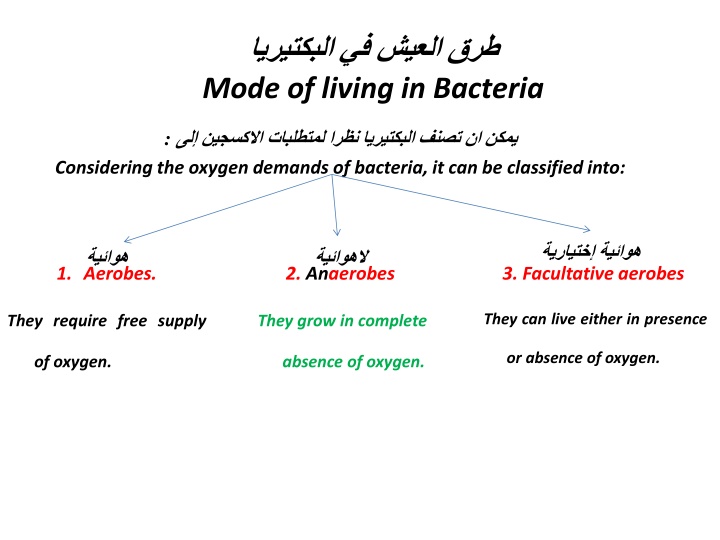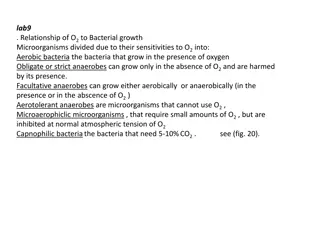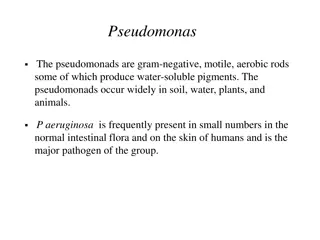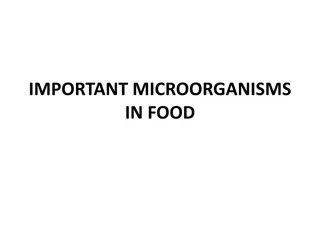Bacteria Living Modes & Nutrition Overvie
Understanding the diverse modes of living and nutrition of bacteria, including aerobes, anaerobes, autotrophic, and heterotrophic categories. Explore the details on oxygen demands, energy sources, and examples of various bacteria types.
Download Presentation

Please find below an Image/Link to download the presentation.
The content on the website is provided AS IS for your information and personal use only. It may not be sold, licensed, or shared on other websites without obtaining consent from the author.If you encounter any issues during the download, it is possible that the publisher has removed the file from their server.
You are allowed to download the files provided on this website for personal or commercial use, subject to the condition that they are used lawfully. All files are the property of their respective owners.
The content on the website is provided AS IS for your information and personal use only. It may not be sold, licensed, or shared on other websites without obtaining consent from the author.
E N D
Presentation Transcript
Mode of living in Bacteria : Considering the oxygen demands of bacteria, it can be classified into: 1. Aerobes. 2. Anaerobes 3. Facultative aerobes They can live either in presence They require free supply They grow in complete or absence of oxygen. of oxygen. absence of oxygen.
Mode of nutrition : 1- Autotrophic CO2 ( ) 2- Heterotrophic . If we consider the mode of nutrition, bacteria can be divided into two categories: 1. Autotrophic. They can build up complex organic substances such as carbohydrates from simple inorganic sources (CO2 and water). 2. Heterotrophic. They cannot build up carbohydrates from simple inorganic sources. They depend on ready made organic materials derived from plants , animals and humans. They can live on such compounds , break it down , enzymatically.
I: Autotrophic Bacteria The autotrophs can be divided into two types: I: Photoautotrophs II: Chemoautotrophs.
: - green sulphur bacteria. A. They contain in their cells a chlorophyll known as bacterial chlorophyll by which they can perform photosynthesis. Here, the energy used in building up processes is derived from light. As an example of such bacteria is the green sulphur bacteria. Photoautotrophs. Light Energy 6CO2 + 12 H2S C6H12O6 + 6 H2O + 12 S Green sulphur bacteria
: - . . B. Chemoautotrophs: Here the cells lack chlorophll. Accordingly the source of energy should be something else than light. The energy used here is released from chemical reactions carried out by such bacteria.
Three examples we have : 1) Nitrosomonas, oxidizes ammonia or ammonium salts to nitrites with a release of energy : 2NH3 + 3O2 2) Nitrobacter, oxidizes nitrites to nitrates with a release of energy : 2HNO2 + O2 3)Thiobacillus thiooxidans, oxidizes sulphur with a release of energy : 2S+3O2 + 2H2O 2 H2SO4 + Energy 2 HNO2 + 2H2O + Energy 2 HNO3 + Energy . The energy released from any of these oxidation reactions is utilized by the specific organism in building up organic carbohydrates from the simple inorganic sources.
II. Heterotrophic Bacteria It utilizes the organic material as essential source for carbon and energy. 1- photoorganotrophic: Chlorophyll :it obtains energy for CO2 reduction from light. But Hydrogen source is organic materials such as alcohol and fatty acid. For example: purple or non sulfur bacteria 2- chemoorganotrophic: most bacteria
II. Heterotrophic Bacteria Heterotrophs live either as Parasites on plants, animals and humans causing serious diseases. Symbionts with other living organisms Saprophytes on dead organic matter. sharing benefit, e.g. Rhizobium (nodule bacteria) which lives in symbiosis with the roots of legumes forming root nodules. It can fix nitrogen and build proteins and other nitrogenous compounds to be partially delivered, to the higher plant and get in return the carbohydrates from the latter.
Bacterial growth . . : 1 2 8 4 ... 16 25, 24, 23, 22, 21, 20 since each original cell divides to form two new cells, with the loss of the original parent. the mathematical series describing growth is: 1, 2, 4, 8, 16, . This can be written as 20, 21, 22, 23, 24, 25, .. The mathematics of bacterial growth is fairly simple,
30 30 ) ( . 1 . The generation time (time needed for the cell to divide into two) differs according to species and prevailing conditions. For example, a bacterium that divides every 30 min has a generation time of 30 min. (Fig 1)
The bacterial growth curve Bacterial growth over time can be graphed as cell number versus time. This is called a growth curve. This curve typically has four distinct phases: Lag Exponential Stationary Death phase (log) phase phase phase . growth curve . : ) ( ) (
Lag phase: * Is the first phase. * No increase in cell number * Cells are actively metabolizing, in preparation for cell division. * It may be short or very long, according to the growth medium, inoculum, cells age, temperature. :) ( Lag phase . . .
Exponential or log phase . . ( .) . 2 - 3 - 1 - Exponential or log phase * Is the second phase. * called the exponential or log phase. * This is the period in which the cells grow most rapidly, doubling at a fairly constant rate. * The time it takes the culture to double is called the generation time. * The generation time depends on several factors:. 1. the organism . 2. the growth medium 3. temperature
Stationary phase: 2 - : 3 - 1 - Stationary phase: * Is third phase . * metabolism slows. * cells cease rapid division. Why? Due to : * high cell density. * depletion of nutrients . * accumulation of waste products.
: Death phase (decline phase): * Is the final phase . * cells quickly lose the ability to divide. * exponential death. ) (
Factors affecting bacterial growth Many factors affect the generation time of the bacterium: Temperature pH oxygen salt concentration and nutrients While most bacteria grow best when these parameters are optimum
Temperature According the temperature degree that bacteria survive, they can classified to : : mesophiles extremophiles. psychrophiles thermophiles The bacteria that grow best from about 0 - 20 C The bacteria that have an optimum above 40 C grow best at ambient temperatures 20 -40 C that grow well at 100- 120 C temperature
: Psychrophiles 20 - Mesophiles 20 40 - Thermophiles 40 100 Extremophiles 120 -
pH Microbes have different optimum pH requirements: 1- Acidophiles: Some bacteria 2- Neutrophiles: most microbes 3- Alkalinophiles: Some bacteria
OXYGEN Required for aerobic respiration and energy production Organisms are classified according to their gaseous requirements: 1. Obligate aerobes 2. Facultative anaerobes 3. Obligate anaerobes
Salinity (salt concentration) 1- Halophiles: Bacteria that specifically requires NaCl for growth 2- Moderates Halophiles: Grow best at 3% NaCl solution Many ocean dwelling bacteria Extreme Halophiles: Grow well at NaCl concentrations of greater than 15% e.g salt lakes, pickle barrels























